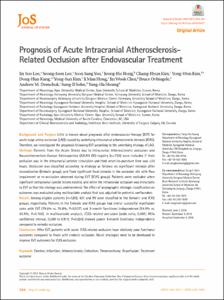Prognosis of Acute Intracranial Atherosclerosis- Related Occlusion after Endovascular Treatment
- Keimyung Author(s)
- Yoo, Joon Sang; Hong, Jeong Ho; Kim, Chang Hyun; Sohn, Sung Il
- Journal Title
- Journal of Stroke
- Issued Date
- 2018
- Volume
- 20
- Issue
- 3
- Keyword
- Cerebral infarction; Atherosclerosis; Embolism; Thrombectomy; Reperfusion; Treatment outcome
- Abstract
- Background and Purpose
Little is known about prognosis after endovascular therapy (EVT) for acute large artery occlusion (LAO) caused by underlying intracranial atherosclerotic stenosis (ICAS). Therefore, we investigated the prognosis following EVT according to the underlying etiology of LAO.
Methods
Patients from the Acute Stroke due to Intracranial Atherosclerotic occlusion and Neurointervention-Korean Retrospective (ASIAN KR) registry (n=720) were included if their occlusion was in the intracranial anterior circulation and their onset-to-puncture time was <24 hours. Occlusion was classified according to etiology as follows: no significant stenosis after recanalization (Embolic group), and fixed significant focal stenosis in the occlusion site with flow impairment or re-occlusion observed during EVT (ICAS group). Patients were excluded when significant extracranial carotid lesions existed, and when the intracranial occlusion was intractable to EVT so that the etiology was undetermined. The effect of angiographic etiologic classification on outcomes was evaluated using multivariable analysis that was adjusted for potential confounders.
Results
Among eligible patients (n=520), 421 and 99 were classified in the Embolic and ICAS groups, respectively. Patients in the Embolic and ICAS groups had similar successful reperfusion rates with EVT (79.6% vs. 76.8%, P=0.537) and 3-month functional independence (54.5% vs. 45.5%, P=0.104). In multivariable analysis, ICAS-related occlusion (odds ratio, 0.495; 95% confidence interval, 0.269 to 0.913; P=0.024) showed poorer 3-month functional independence compared to embolic occlusion.
Conclusions
After EVT, patients with acute ICAS-related occlusion have relatively poor functional outcomes compared to those with embolic occlusion. Novel strategies need to be developed to improve EVT outcomes for ICAS occlusion.
- Publisher
- School of Medicine (의과대학)
- Citation
- Dong-Hun Kang et al. (2018). Prognosis of Acute Intracranial Atherosclerosis- Related Occlusion after Endovascular Treatment. Journal of Stroke, 20(3), 394–403. doi: 10.5853/jos.2018.01627
- Type
- Article
- ISSN
- 2287-6405
- Source
- https://www.j-stroke.org/journal/view.php?doi=10.5853/jos.2018.01627
- Appears in Collections:
- 1. School of Medicine (의과대학) > Dept. of Neurology (신경과학)
1. School of Medicine (의과대학) > Dept. of Neurosurgery (신경외과학)
- 파일 목록
-
-
Download
 oak-2018-1665.pdf
기타 데이터 / 1.05 MB / Adobe PDF
oak-2018-1665.pdf
기타 데이터 / 1.05 MB / Adobe PDF
-
Items in Repository are protected by copyright, with all rights reserved, unless otherwise indicated.